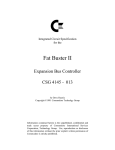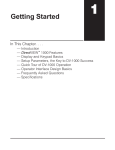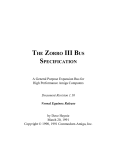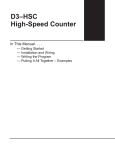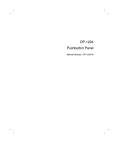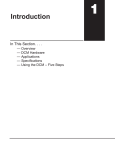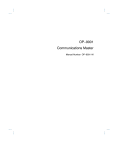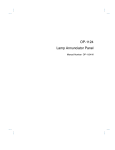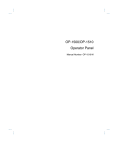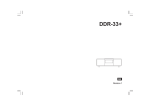Download Chapter 1
Transcript
Getting Started In This Chapter. . . . — Introduction — HSC Features — How Does the HSC Work With the CPU? — Physical Characteristics & Specifications — Overview of HSC Inputs and Outputs — X Input and Y Output Assignments — Putting It All Together 11 1--2 Getting Started D4--HSC Getting Started Introduction The Purpose of this Manual Thank you for purchasing the High Speed Counter module for the DL405. This manual shows you how to install, program, and maintain the equipment. It also helps you understand the module’s operating characteristics. Since we constantly try to improve our product line, we occasionally issue addenda that document new features and changes to the products. If an addendum is included with this manual, please read it to see which areas of the manual or product have changed. HIGH SPEED CNTR TB CW OT2 CCW OT1 PWR C<P C=P C>P OVR VE RST LTH RUN INH INA INB LD1 LD2 D4-HSC INA INB INZ LD RST LATCH C.INH RUN LS1 LS2 L -V + CW L CCW L OUT1 L OUT2 12/24VDC 1A Who Should Read this Manual If you understand PLC systems, this manual will provide all the information you need to get and keep your High Speed Counter module up and running. We will use examples and explanations to clarify our meaning and perhaps help you brush up on specific features used in the DL405 system. This manual is not intended to be a generic PLC training manual, but rather a user reference manual for the DL405 High Speed Counter Module. Where to Begin If you are in a hurry and already understand the basics of high speed counters and basic motion control,you may only want to skim this chapter, and move on to Chapter 2, Installation and Wiring. Be sure to keep this manual handy for reference when you run into questions. If you are a new DL405 customer, we suggest you read this manual completely so you can fully understand the high speed counter module’s configurations and the procedures used. We believe you will be pleasantly surprised with how much you can accomplish with PLCDirectä products. Depending on the products you have purchased, there may be other manuals necessary for your application. You will want to supplement this manual with any other manuals written for other products. We suggest: Supplemental Manuals S S Technical Assistance D4-USER-M (the D4-405 User Manual) DA-DSOFT-M ( the DirectSOFT User Manual) If you have questions that are not answered by this manual, our Technical Support Team is glad to help. They are available from 9:00AM until 6:00PM Eastern Time Monday through Friday at 800-633-0405. Getting Started 1--3 1 Getting Started 2 Installation and Wiring 3 Understanding Operation 4 Setting Up and Controlling the Count 5 Controlling the Outputs 6 7 Special Features Applications includes a brief description of the high speed counter module, common applications for high speed counters, and an overview of the steps necessary to setup and operate the high speed counter. shows you step-by-step how to install and wire the HSC. Includes wiring diagrams. a must for understanding the rest of the manual. It covers the shared memory concept, the assignment of data types for the HSC, and how values are stored. covers offsets and presets, which are needed for many applications. It provides the programming tools needed to make full use of the counting capability. It includes count inhibiting, count latching and overflow flags. this chapter introduces you to the HSC’s four different control outputs. It shows you how HSC RUN uses your preset information and current count to trigger the outputs in an ordered format. It also covers “manual’ operation of the outputs without using HSC RUN. covers two special features that have been built into the HSC. You will learn about sampling and home search capabilities. shows you how to write programs that will provide possible solutions for some common applications you might encounter. Appendices A although PLCDirectä does not provide encoders or motor Introduction to Motor drives, we have included a brief overview explaining some of Drives and Shaft Encoders the more common encoders and electronic drives that may be used with the D4-HSC High Speed Counter. B Introduction to Motor this includes the X and Y data type assignment chart and an address map for the seven shared memory parameters. Drives and Shaft Encoders Other Resources You can also check our online resources for the latest product support information: S Internet -- the address of our Web site is http://www.plcdirect.com S Bulletin Board Service (BBS) -- call (770) 844--4209 The “note pad” icon in the left-hand margin indicates the paragraph to its immediate right will be a special note. The “exclamation mark” icon in the left-hand margin indicates the paragraph to its immediate right will be a warning or caution. These are very important because the information may help you prevent serious personal injury or equipment damage. D4--HSC Getting Started Below is a table showing a summary of contents provided within each section of this manual. The manual is organized into the following seven chapters: Chapters 1--4 Getting Started D4--HSC Getting Started HSC Features What is a High Speed Counter? Who Needs a High Speed Counter? Literally, high speed counters count fast! The D4-HSC high speed counter has one channel for counting pulses from sensors, encoders, switches, and so on, at rates up to 100 kHz (50% duty cycle). It is designed to make your job simpler. The HSC has its own microprocessor that asynchronously counts and accumulates the high speed pulses. This means the main CPU of the DL405 is free to do the other important tasks. It can simply check the accumulated count when it needs to do so. If you have an application that needs to count pulses rapidly, then you are a prime candidate for an HSC. The D4-HSC also has 4 outputs that can be used for controlling motor speed and direction. There is one special requirement. The variable speed motors or motor drives that are used must be capable of changing speed when receiving a voltage input between 10.2 VDC and 26.4 VDC. Many digital drives being offered today offer programmable input capability, precisely for this sort of application. 3 Counting Inputs: 4 Outputs: CW or CCW OUT1 INZ H INB S C CPU OUT2 INA drive encoder NOTE: The motor control capability should not be confused with a pulse output capability such as used with stepper motors. The D4-HSC outputs a voltage level dependent on an external power supply and does not have pulse output capability. You should check the specs of your drive or motor carefully to make certain that the specifications of this module match your application requirements. Types of Counting Standard Counting The D4-HSC can do standard UP and DOWN counting or it can do quadrature counting. These are software selectable as two different modes. With standard counting you can use the two counting input signals (INA and INB)of the D4-HSC. One input is used for counting UP and the other used for counting DOWN. You can’t use both inputs for the same direction of counting. Standard Counting Using Two Inputs One Channel Encoders UP INA INB You could be using only one of the inputs if desired. In this case, the other input terminal should be left unwired. You control the direction of counting by the manner in which you set a certain bit in your control program (shown later). Standard Counting Using One Input INA DWN One Channel Encoder UP or DWN INB Unused 1--5 Getting Started Output Control With quadrature counting, you must use both signals (INA and INB). Both input terminals are connected to the same field device, capable of outputting two square wave signals, each being offset 90 degrees. Quadrature counting is often preferred to standard counting because it can sense direction. Quadrature inputs are also more noise immune. With quadrature counting, the direction (UP or DOWN counting) is determined by whether the signal being received at INA leads or lags the signal received at INB. The D4-HSC looks at the signals coming in and compares them. It then determines which is leading and which is lagging. NOTE: We have not shown the optional use of the Z-output signal (connected to INZ of the HSC) that comes standard on most quadrature encoders. The use of this input option will be discussed when we cover resetting the counter externally and the automatic home search feature. Quadrature Counting Quadrature Encoder INA INB Leading and lagging signals With a rotary encoder, the leading and lagging signal is determined by which direction the shaft is turning. This is how quadrature counting is able to sense direction. A typical application for the D4-HSC might be that of having a quadrature type shaft encoder connected to your motor with the HSC counting and accumulating the pulses from the encoder as the motor rotates. The HSC knows which way the motor shaft is turning because it knows which of the two signals being received is leading and lagging. You can write ladder logic to change either the motor’s speed or direction. (We’ll show you how to do that a little later!) The D4-HSC provides output signals that can be used to change speed or direction. Usually these signals are connected to an electronic drive or motor controller rather than the motor itself. Some motors are “smart” with built-in logic circuitry for initiating speed and direction changes. In these exceptional cases, the HSC can be connected directly to the motor to initiate the changes. We leave it up to you to specify the motor control and thus dictate the load side of the application. Make sure you check the specs of your motor or motor controller and that you are sure they match up with the specs of D4--HSC before making any connections. Pulse Signals In INA INB CW CW is the clockwise signal output. It is just one of four possible outputs. Drive Level Signal Out Output Control Motor Encoder D4--HSC Getting Started Quadrature Counting 1--6 Getting Started D4--HSC Getting Started Sampling Home Search The HSC can also do sampling over time. That is, you can use simple ladder logic instructions to indicate the time period for a sampling. When you invoke the sampling feature of the HSC, it will keep track of the counted pulses for the time period you have specified and store the total for later RLL retrieval. This is a great feature for determining frequency of incoming pulses. It’s as simple as specifying a time base, say 3 seconds, and then counting the pulses for that period. If the HSC sees 6000 pulses during that time span, then you know that you have an incoming pulse rate of 2 kHz (6000/3=2000). There are many other uses for the sampling feature----frequency counting is just one example. Many applications require a known starting position for a given work cycle, called “home point”. This is the point to which the moving piece of apparatus doing the work (i.e. welder, drill, saw, glue gun, etc.) is returned at the end of each work cycle. The HSC has an automatic feature that is designed to help find and return to a home position at the end of each work cycle. You could, of course, write your own home search RLL. However, the D4-HSC relieves you of that task. Since the algorithm associated with the automatic home search routine assumes a certain type of configuration, you will have to make sure that the components and position of each meets certain specified criteria. Then, you activate the home search using a Y-output relay. The HSC takes over from there. We’ll show you how to do this later in this manual. Work Area Boundaries Encoder Drill Head Home Point Motor Lead Screw Limit Switch LS1 Limit Switch LS2 Work Piece Typical Home Search Setup HSC Power Supply Motor Controller Getting Started 1--7 How Does the HSC Work With the CPU? The diagram below shows you the basic concept. Chapter 4 will cover the subject in depth. The CPU and the HSC do not communicate directly. They do so by exchanging information to and from the shared memory area, via the CPU’s V-Memory. Your ladder logic decides what information and when it is read and written between the two memory areas. CPU HSC V-Memory Shared Memory D4--HSC Getting Started Setup Performed The D4-HSC is an intelligent module that has its own microprocessor and memory. Via Shared Memory The microprocessor operates asychronously to the DL405 CPU. Its memory area is called “shared memory”, because both the DL405 CPU and the HSC can read and write to this area. In fact, that’s how you handle important items like-- telling the counter your preset value. In this case, you store parameters first in your DL405 CPU’s V-memory area; and then you transfer them to the shared memory area. Then, the HSC can read and use the information. The HSC microprocessor cannot read information directly from the DL405’s V-memory area. Likewise, it cannot write information directly into the CPU’s V-memory area. This is why the two-step process is always necessary. 1--8 Getting Started D4--HSC Getting Started Physical Characteristics & Specifications LED Assignments Label LED Assignments HIGH SPEED CNTR PWR C<P C=P C>P OVR Function PWR 5V POWER ON C<P CURRENT COUNT LESS THAN PRESET C=P CURRENT COUNT EQUAL TO PRESET C>P CURRENT COUNT MORE THAN PRESET OVR COUNT OVERFLOW TB LOOSE OR MISSING TERMINAL BLOCK CW CLOCKWISE OUTPUT ENERGIZED OUT2 BRAKE (OUT2) OUTPUT ENERGIZED CCW COUNTER CLOCKWISE OUTPUT ENERGIZED TB CW OT2 CCW OT1 INPUT A INA INPUT B INB OUT1 DECELERATION (OUT1) OUTPUT ENERGIZED EXTERNAL POWER SUPPLY FOR OUTPUTS FAILED RST SIGNAL APPLIED TO RESET INPUT (External Only) LTH SIGNAL APPLIED TO LATCH INPUT (External Only) RUN SIGNAL APPLIED TO RUN INPUT (External Only) INH SIGNAL APPLIED TO INHIBIT CNT INPUT (External Only) LIMIT SWITCH 1 LS1 INA SIGNAL APPLIED TO INA INPUT LIMIT SWITCH 2 LS2 INB SIGNAL APPLIED TO INB INPUT SIGNAL APPLIED TO INZ INPUT LD2 SIGNAL APPLIED TO LD INPUT INA INB LD1 LD2 Terminal Assignments VE LD1 VE RST LTH RUN INH INZ LD INPUT Z LOAD OFFSET RESET COUNTER RST LATCH COUNT LATCH COUNT INHIBIT C.INH RUN HSC RUN V L CLOCKWISE OUTPUT -+ CW COUNTER-CLOCKWISE OUTPUT L CCW DECELERATION OUTPUT L OUT1 BRAKING OUTPUT L OUT2 12/24VDC 1A EXTERNAL POWER SUPPLY General Specification Rating or Requirement 405 CPU Firmware Requirements Any PLCDirect CPU or other vendor’s 405 CPU (Version 1.6 or later.) Slot for Installation Can be installed in any CPU or expansion base. Cannot be installed in a remote base. Maximum No. HSC’s per CPU 8 No. of I/O points required Consumes 16 X-inputs and 32 Y-outputs Intelligence Source Has its own microprocessor (operates asynchronously to the DL405 CPU) Internal Power Consumption 300 mA maximum at 5VDC Field Wiring Connector Removable terminal type Count Signal Level 4.75VDC to 30VDC less than 10mA Maximum Count Speed 100 kHz (50% duty cycle) Minimum Input Pulse Width for Counting 5 ms (either state) Count Input Signal Types Standard (UP/DOWN) or quadrature (phase differential) Count Range --8,388,608 to +8,388,607 Count Direction UP or DOWN (software selectable or hardwired) CPU Scan Time Increase per HSC in base 4.2 to 5.5 ms Getting Started Counting Inputs (INA, INB, INZ) 1--9 Rating or Requirement 4.75VDC to 30VDC Maximum Input Current 10 mA ON Voltage = 4.75VDC ON Current = 5mA OFF Voltage = 2.0VDC OFF Current = 1.6mA OFF to ON Delay = 1.2ms at 5VDC = 0.8ms at 12VDC = 0.5ms at 24VDC ON to OFF Delay = 1.0ms at 5VDC = 1.2ms at 12VDC = 2.5ms at 24VDC D4--HSC Getting Started Input Voltage Range Control Inputs (LD, LATCH, RST, CINH, RUN, LS1 LS2) Rating or Requirement Input Voltage Range 10.2VDC--26.4VDC Maximum Input Current 10mA ON Voltage =10.2VDC ON Current =5mA (LD and LATCH); ²4.8mA (RST,CINH,RUN,LS1 and LS2) OFF Voltage =4.6VDC (LD and LATCH); ±5.6VDC (RST,CINH,RUN,LS1 and LS2) OFF Current =1.6mA (LD and LATCH); ±2mA (RST,CINH,RUN,LS1 and LS2) OFF to ON Delay =75ms at 12VDC (LD and LATCH) =82.5ms at 12VDC (RST,CINH,RUN,LS1 and LS2) =30ms at 24VDC (LD and LATCH) =37.5ms at 24VDC (RST,CINH,RUN,LS1 and LS2) ON to OFF Delay =240ms at 12VDC (LD and LATCH) =105ms at 12VDC (RST,CINH,RUN LS1 and LS2) =260ms at 24VDC (LD and LATCH) =105ms at 24VDC (RST,CINH,RUN LS1 and LS2) Control Outputs (CW,CCW,OUT1,OUT2) Rating or Requirement Output Power Source External 10.2VDC--26.4VDC, 1A Output Type Open Collector Maximum Output Current 100 mA per point Output ON Voltage Drop = 1.5VDC Output OFF Leakage Current = 100mA Output OFF to ON Delay = 22.5ms at 12VDC = 21ms at 24VDC Output ON to OFF Delay = 210ms at 12VDC = 270ms at 24VDC Built--In Protection Shut off when output driver IC=175_C (Recovers at 150_C) Shut off when short (>500mA) is detected (Recovers when short is removed) Input-pulse-reaching-Preset to internal-signalreaching-Output 1 Time Delay 110ms 1--10 Getting Started D4--HSC Getting Started Overview of HSC Inputs and Outputs Counting Inputs INA--Depending on mode chosen, this is either a standard UP/DOWN counter input, or one of the quadrature counter inputs. INB--Depending on mode chosen, this is either a standard UP/DOWN counter input, or one of the quadrature counter inputs. INZ--This input can be used to help you find home position for positioning control. It can also be used as an external means of resetting the counter. HIGH SPEED CNTR PWR C<P C=P C>P OVR TB CW OT2 CCW OT1 VE RST LTH RUN INH INA INB LD1 LD2 D4-HSC Control Inputs LD--If you want to use an offset number with your counting, a rising edge signal at this terminal will copy the offset value into the current count. RST--A high (ON) signal at this terminal resets the counter to zero and it remains there until there is a transition to a low signal (OFF). LATCH -- You may want to store the current count. The rising edge of a signal at this terminal will store the current count in shared RAM. Counting continues with no interruption. INA INB INZ LD RST LATCH C.INH-- You may want to temporarily ignore the count inputs coming in on INA and INB. A high (ON) signal at this terminal will inhibit the counting to accomplish this need. Current count is suspended until a transition to a low (OFF) signal is seen. RUN--Not to be confused with RUN mode of the DL405,a high (ON) signal here will activate HSC RUN. A low (OFF) signal will de-acitivate it. LS1 or LS2--Either or both of these terminals can be connected to limit switches to help find home position, or they can merely be used as discrete inputs. Control Outputs C.INH RUN LS1 LS2 V L -+ CW L CCW L OUT1 L OUT2 12/24VDC 1A CW--You connect the output of this terminal to the appropriate terminal of your motor controller for clockwise motion when current count is less than preset and HSC RUN is ON, or when the output has been turned ON with RLL. CCW--You connect the output of this terminal to the appropriate terminal of your motor controller for counter-clockwise motion when current count is more than preset and HSC RUN is ON, or when the output has been turned ON with RLL. OUT1 -- As you approach a target position, you may need to trigger motor deceleration. A signal from this output can do that. This is used in the automatic home search algorithm also. OUT2 -- When you reach your target (current count=preset), you may need to activate a brake to stop the motor. A signal from this output can do that. Y Data Type Equivalents for Some Functions LD, RST, LATCH, C.INH, and RUN all have software equivalents built-in to the logic of the D4-HSC. These are Y data types that are discussed on the next page. Thus, you have your choice of either triggering these control inputs externally or accomplishing essentially the same task internally from within your RLL. They have been shaded to make them easy to spot. NOTE: Use external inputs if immediate responses are needed. When a function is activated through RLL (Y-outputs in this case), the function will not activate until the I/O update has been performed. This delay is dependent on your CPU’s scanning speed and the size of your program. Getting Started 1--11 X Input and Y Output Assignments X No. In this example we have placed the HSC in slot 0 of the CPU base. This simplifies X and Y identification because X’s and Y’s both start at 00. Xn+0 ON if current count is greater than preset Xn+1 ON if current count is equal to preset Xn+2 ON if current count is less than preset Xn+3 Latched ON if overflow occurs (reset with Ym+1) Xn+4 Xn+5 Status of CCW output Status of OUT2 (brake) output Xn+6 Status of CW output Xn+7 Xn+10 Status of OUT1 (deceleration) output Xn+11 Xn+12 Xn+13 H S C IN OUT OUT X00-X17 Y00-Y37 For example: Xn+6=X6=Status of CW output Ym+3=Y3=ON for HSC RUN Function Status of Limit Switch 2 Status of Limit Switch 1 ON if doing a search for home position ON if a sampling is being conducted Xn+14 NOT USED Xn+15 Xn+16 ON for missing terminal block Y No. ON if external power supply for outputs is missing or OFF Function Ym+0 ON to reset OUT1 and OUT2 when in HSC run Ym+1 ON to reset overflow flag (Xn+3) Ym+2 Rising edge of this signal copies offset value into current count Ym+3 ON for HSC run Ym+4 Used to control CCW when not in HSC RUN or Home Search Ym+5 Used to control OUT2 when not in HSC RUN or Home Search Ym+6 Used to control CW when not in HSC RUN or Home Search Used to control OUT1 when not in HSC RUN or Home Search Ym+7 D4--HSC Getting Started There are certain X’s and Y’s reserved by the D4-HSC. By convention, we will be referring to these assignments as Xn+(z) and Ym+(z) where n and m are offset values based on which slot of the CPU base you have placed your HSC. The letter z will be some octal number that maps the X or Y to a specific input or output function. For example if you have the HSC in slot 0, and are using automatic addressing, then m and n will both be equal to zero. In such case, the data type assignments would be as shown below. All of this is explained in great detail in Chapter 4. You will also at that time be given a complete table of the X and Y assignments. 1--12 Getting Started D4--HSC Getting Started Putting It All Together Up to this point, we have given you only the very basic information about the HSC module. The six chapters that follow will give you the additional information you need to make full use of the HSC. There are five basic steps for using the HSC. Five Steps for Using the HSC The Next Chapter Document Install the Module and Connect the Wiring — Chapter Two Document Understand How the Module Maps into the I/O Points, and How the Setup Information is Stored — Chapter Three Document Setup the Counting and Control Input Parameters — Chapter Four Document Setup the Control Outputs — Chapter Five Document Setup Any Special Features, Such as Home Search or Sampling — Chapter Six The next chapter will walk you through the installation and wiring before moving you on to Step 2.












